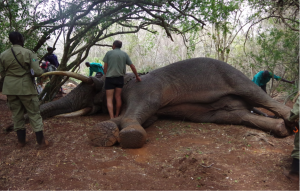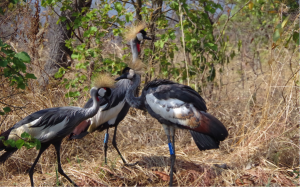Guest Post by Tracy Keza.
Populations of African bush elephants (Loxodonta africana) have dramatically decreased from roughly 1.3 million to 600,000 individuals between 1979-1987. This steep decline has been attributed to poaching and the black market for their ivory and meat. Experts believe that over the next 15-20 years, this species of elephants will be completely extinct if nothing is done to put an end to poaching. Particularly vulnerable and attractive to poaching are the oldest matriarchs due to their large tusks, and also because they tend to travel in large slow-moving groups with their calves.
Akagera National Park in eastern Rwanda is taking a precautionary approach to prevent resident elephants from being poached after an incident in which a patriarchal bull went missing and was found dead on the Tanzanian border where it had been killed for it’s tusks. To protect the 90 elephants that currently live in the park from poachers, I recently helped Park officials collar the elephants with GPS devices that can be tracked remotely using satellites and telemetry equipment. A total of 6 elephants were tagged and will continued to be monitored by staff to help prevent further poaching. In addition to monitoring the elephants movements, the purpose of collaring these elephants was to gather information about them and better understand how they fit into their ecosystem. African bush elephants play a significant role in the biological diversity of African ecosystems. They are keystone species that are instrumental in maintaining the balance of other species in the park, for example by pulling down trees and breaking up thorn bushes that provide ideal habitat for other animals. Due to the park’s thick savannah vegetation it’s rather difficult to locate a matriarchal or patriarchal elephant. A helicopter was dispatched to locate individual elephants, which were then targeted by ground crews for collaring. One of the problems with collaring these elephants is that even though they don’t have great eye sight, they have an incredible sense of smell. This poses a potential problem and requires rangers to constantly be aware of the direction of the wind before the elephant is darted. Akagera National Park vet Pete Morkel was very happy with the overall success of the collaring program, for instance the male elephant pictured, which he darted with a tranquilizer on it’s right thigh. It took approximately 20 minutes from the time the elephant was put down for the drugs to wear off so that it could get back on it’s feet again. The collars are deployed as quickly as possible to reduce the stress of the darted animal. The 47 year old bull was tracked the next day roaming nearby fields with no complications at all.
Tracy Keza is an Environmental Sciences major at Trinity College, and spent much of the past summer (2014) working as an intern in the Office of the President in her native Rwanda.



Hello my friend! I want to say that this article is awesome, nice
written and come with approximately all important infos.
I would like to peer more posts like this .